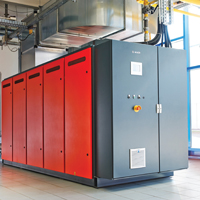 Future Proofing Combined Heat & Power
Future Proofing Combined Heat & Power
As carbon reduction targets become more and more strict and fuel prices continue to rise, it has never been more prevalent that heating and hot water systems achieve maximum efficiency. Ben Richardson, Combined Heat and Power (CHP) Commercial Technology Consultant at Bosch Commercial and Industrial Heating, explains the need to think ahead before sizing CHP modules: (Read More)
“Interest in energy management in the UK has increased significantly in recent years due to new UK and EU targets to reduce carbon emissions and improve energy performance. Legislation, such as the Ecodesign of Energy Related Products (ErP) Directive, now play a key role in influencing how manufacturers and system operators view energy consumption and how they intend to reduce it.
Advertisement - Hover to see more
Advertisement - Hover to see more
“The installation of low carbon technologies is obviously a good step towards enhancing energy efficiency. But when looking to implement a CHP module into a building, both electrically and thermally, it is vitally important to take into account all energy efficient technology used, now and in the near future, to ensure the module performs to its full capabilities for its entire lifespan.
Sizing CHP
“A CHP installation will only be maximising its efficiency to the full if the system is designed to utilise 100 per cent of the heat generated. Although the Combined Heat & Power Quality Assurance Programme (CHPQA) allows a proportion of the heat to be rejected throughout the year, ideally all heat should be utilised to maximise efficiency. With premium efficiency levels and cost savings the ultimate objective for such an arrangement, it is vital that no heat is rejected, as this would have the potential to jeopardise the system’s effectiveness and significantly increase the payback period. Failure to do so from the outset of a project is likely to result in the production of too much heat for a building, which will nullify any potential efficiency gains.
“However, it is important to look past current CHP requirements and view how any potential future energy saving technologies due to be installed will affect its performance over its lifecycle. For instance, as the Ecodesign of Energy Related Products (ErP) Directive second phase rolls out in 2015, any application using fans or motors will have to meet improved minimum efficiency standards which can have a significant impact on the sizing of CHP modules.
Sizing a CHP module on today’s energy needs can lead to an oversized inefficient system once future energy saving technologies have been implemented. The opposite is also true, future expansion may increase energy demands and a larger CHP module could provide increased efficiencies.
“To ensure a CHP system is correctly sized, first you must take the energy data of all heating, hot water and electrical technologies, both already installed and planned in the near future, into consideration during the design stage. Once this has been calculated, a CHP system should be sized either to the thermal base load of a project, or 20 per cent of the peak load, to allow for maximum efficiency.
“Whilst CHP will meet a building’s base heating load requirements most of the time, a secondary source will be required in some cases to satisfy its peak heating load. In some instances this may only equate to a few months a year, but during these times, CHP alone would not be the most efficient solution.
“There is a temptation to push the potential gains to the maximum, but this can lead to heat being rejected or electricity frequently being spilled into the grid. In addition, poorly designed schemes can lead to operational difficulties and increased maintenance requirements and costs.
“The use of buffer vessels can help to even out the peaks and troughs in thermal demand, whilst simultaneously extending the run time of the CHP module and storing useful heat until it can be used. Buffer vessels are generally sized to give one hour’s run time for the CHP module, which has proven to work well. Thought needs to be given to the integration of the buffer vessel into the system, to ensure it is dedicated to the requirements of the CHP module and does not create any hydraulic or control difficulties.
“As legislation drives us to become more conscious of our energy consumption and incorporate further energy efficient technologies into heating, hot water and electrical systems, it is the work conducted at the early stages of a CHP system design that will ensure it is effective in operation. This means not only assessing current CHP requirements, but how this may be affected by any potential additions to the base load in the near future.
“Correct sizing of a CHP system is essential to ensure the balance between providing useful heat and electricity, and maximising savings. In addition, it is vitally important that these metrics be measured over the full lifecycle of the CHP module, and not just the initial period. A well thought out system design will increase the likelihood of a favourable return on investment, which will in turn lead to quicker payback on the initial financial outlay.”
For more information on Bosch Commercial and Industrial Heating, its range of light commercial and commercial CHP modules, and CHP CPD training, visit:
www.bosch-industrial.co.uk.




